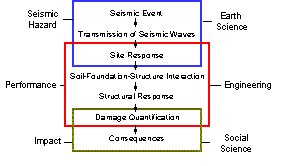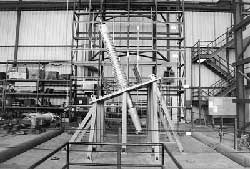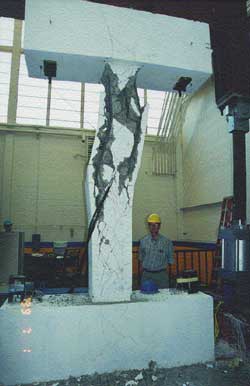
Pacific Earthquake Engineering Research Center
University of California at Berkeley (lead institution)
![]()
Developing seismic design technologies to meet the diverse economic and safety needs of owners and society
| A National Science Foundation Engineering Research Center since 1997 |
![]()
|
Partner Institutions:
|
Earthquakes in the 1990s repeatedly have demonstrated their destructive potential in terms of fatalities, economic losses, and functional disruption. The Pacific Earthquake Engineering Research Center (PEER) operates programs aimed at cost-effective reduction of earthquake losses, with emphasis in the following areas:
- Understanding and mitigating the potential for collapse in older building construction so that major losses of life can be avoided
- Developing performance-based approaches for design of buildings and transportation and utility lifelines to provide life-safety protection for all construction, and protection of economic and functional objectives for essential facilities and operations.
 |
| Performance-based seismic assessment |
PEER links researchers in earth sciences, engineering seismology, engineering, architecture, economics, and public policy to bridge gaps in knowledge so that new technologies can be developed and implemented to achieve the diverse life-safety, economic, and functional requirements of owners and society. PEER's mission is to develop and disseminate technology for design and construction of buildings and infrastructure to meet those diverse seismic performance objectives.
Research
Property owners and society demand increasingly more cost-effective and reliable means of achieving minimum life safety protection in conventional construction, as well as enhanced performance objectives for essential facilities and key industries. Advances in the earth sciences related to seismic hazard, and in computational procedures related to modeling and computation of response of the built environment, can be coupled with economic models to simulate effects of earthquakes on the built environment and society. The challenge to the PEER research program is to bridge the gaps between these different disciplines to develop a performance-based, systems-level approach to seismic evaluation and design.
 |
| Earthquake simulator testing of utility lifeline equipment |
The initial focus of the research program is on performance-based seismic assessment, where the emphasis is on developing models of individual phenomena and their interactions, from seismic hazard through to impact, as illustrated in the figure. The program will mature to consider performance-based seismic design, enabling selection of optimal design objectives to minimize life-cycle costs.
PEER conducts both basic and applied research to resolve societal and industry-specific problems. Current program emphases are on older, existing collapse-hazard concrete buildings; transportation systems including bridges, highways, and ports; and utility lifelines.
Education
PEER research students are exposed to and involved in the cross-disciplinary aspects of the research program. At the lead institution, graduate students from four different departments participate in various programs. A Student Leadership Council involving students from all nine participating institutions involves the students in Center planning and fosters development of leadership skills. Student-run seminars invite industrial representatives from the Business and Industry Partner program to campuses to discuss their current projects and technology needs with students and faculty. PEER faculty develop World Wide Web graduate course modules relevant to the theme of the Center. An REU program involves undergraduates from PEER schools as well as other schools throughout the United States in PEER research at the core institutions. An Undergraduate Scholars Course involves selected students in a four-weekend long course on performance-based earthquake engineering, and exposes students to opportunities at the PEER core institutions. A Graduate Fellowship provides up to a three-year stipend to attract and retain potential doctoral students from underrepresented groups.
Industrial Collaboration/Technology Transfer
 |
| Graduate student research on column performance |
Industry and government partners are an integral part of the research program at PEER. For an annual membership fee, the PEER Business and Industry Partnership involves members in PEER research and education programs and provides preferred access to PEER researchers and products. Researchers share individual research plans and findings with partners having similar interests. Business and Industry Partners are invited to present recent projects and technological needs at student-organized seminars, where they also have the opportunity to interact with PEER students and faculty. PEER holds frequent meetings to summarize research progress and seek input on the PEER core research program. PEER also runs state-of-the-art and state-of-the-practice workshops on selected topics related to the PEER mission, and invites Business and Industry Partners to attend free of charge. Selected representatives of the Business and Industry Partnership plus representatives of key government agencies providing funding for PEER are members of an Implementation Advisory Board, which advises PEER on its strategic plan, its research projects, implementation of research results, and new opportunities for funding.
PEER works with selected industry and government partners to develop and manage long-term major research programs using leveraged funding. For example, PEER brings together representatives from the utility industry, the California Energy Commission, the California Department of Transportation, and PEER to form the Lifelines Joint Management Committee. That group seeks out funding and manages the resulting funds in support of the PEER Lifelines Research Program.
Facilities
The University of California at Berkeley has provided 4,000 square feet for the administration and office space of the PEER Center at the University's Richmond Field Station. This facility is linked through teleconferencing systems to the core institutions.
The Center brings outstanding and unique research facilities together in a single network. Experimental facilities include geotechnical centrifuge systems, reaction wall systems, strong floor testbeds, and shake table facilities and the largest centrifuge, the largest three-dimensional shaking table, and the largest strong-wall/test floor facilities currently operating in the United States. The network of unique facilities, linked by a modern telecommunications system, facilitates multi-institutional coordinated research to be carried out as part of the Center.
Information systems for earthquake engineering are available at UC Berkeley and Caltech through the National Information Service for Earthquake Engineering, as well as the CUBE/REDI programs for real-time earthquake information, and at USC as part of the SCEC Outreach Program. Additionally, the Earthquake Engineering Library at UC Berkeley, which makes its collection of over 30,000 titles available throughout the United States, is closely affiliated with the Center. The Center works with and through these and other established information systems to introduce an enhanced vision of earthquake engineering research dissemination.
![]()
Center Headquarters
Pacific Earthquake Engineering
Research Center
1301 S. 46th Street
Richmond, CA 94804
Tel (510) 231-9554 · Fax (510) 231-9471
Homepage: http://admin@peer.berkeley.edu
Center Director: Professor Jack Moehle (UC Berkeley)
(510) 231-9554 · moehle@peer.berkeley.edu
Deputy Director for Research: Professor Gregory Deierlein (Stanford University)
(650) 723-0423 · GGD@stanford.edu
Assistant Director/Industry Programs: Professor Gregory Fenves (UC Berkeley)
(510) 643-8543 · fenves@ce.berkeley.edu
Assistant Director/Education: Professor Gerard Pardoen (UC Irvine)
(949) 824-7094 · gpardoen@uci.edu
Administrative Director: Ms. Darlene Wright (UC Berkeley)
(510) 231-9505 · darlene@peer.berkeley.edu
Director of Public Relations and Outreach: Mr. Parshaw Vaziri
(510) 231-9550 · vaziri@peer.berkeley.edu
NSF 00-137n